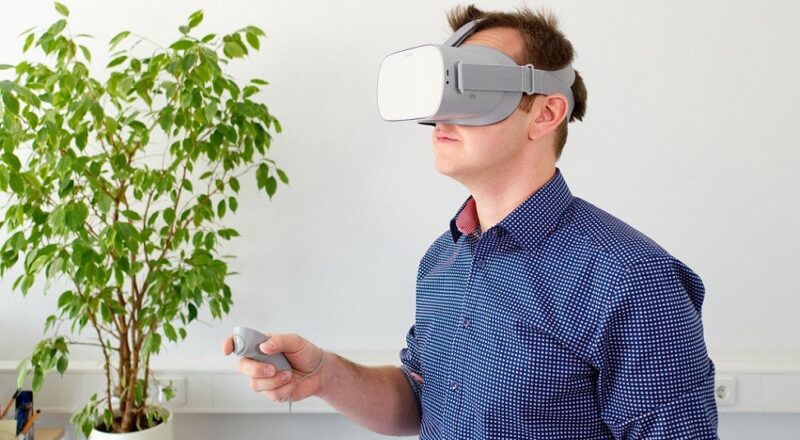Augmented Reality and Virtual Reality are becoming popular in today’s world of technology. What do they mean? How do they work? We will explore the differences between AR and VR, how they work, and the many applications of each. Let’s get started!
What is Augmented Reality (AR)?
Augmented reality app development is gaining popularity as it offers businesses the opportunity to create innovative and interactive experiences for their customers. In Augmented Reality, objects in the real world are combined with virtual elements. Next-gen gaming Arenas are blurring the lines between AR and VR, creating immersive and engaging gaming experiences that transcend the physical and digital worlds. AR allows you to see and interact with digital information overlaid on top of the physical world around you. A variety of devices can accomplish this, including smartphones, tablets, and special glasses.
How does AR work?
AR works by using sensors to detect and track objects in the real world. It then uses this data to place virtual elements in the correct position relative to the objects around you. For example, if you are looking at a street sign through your smartphone’s AR app, the app would use GPS data to determine your location and then place a virtual sign on top of the real one. Augmented reality development services can create AR apps for a wide variety of purposes, such as education, gaming, navigation, and more.
What is Virtual Reality (VR)?
Virtual Reality is a technology that allows you to experience and interact with simulated worlds. VR can transport you to completely different environments, such as historic locations or imaginary worlds. VR is usually experienced through special headsets that provide an immersive, 360-degree experience.
How does VR work?
VR works by creating a simulated environment that you can interact with. This is done by tracking your head movements and projecting the appropriate images onto the headset’s screens. This creates the illusion that you are actually in the virtual world that you are seeing.
Virtual Reality (VR) vs. Augmented Reality (AR)
The key difference between AR and VR is that AR uses real-world objects as a basis for the virtual elements, while VR creates its virtual world. This means that with AR, you can still see the real world around you, whereas with VR you are immersed in the virtual environment.
Advantages of Augmented Reality (AR)
There are many advantages to using AR technology. AR can be used for various purposes, including education, training, gaming, and marketing. AR is also very versatile and can be used on various devices, from smartphones to special glasses.
Advantages of Virtual Reality (VR)
There are many advantages to using VR technology. VR is great for immersive, 360-degree experiences that transport you to other worlds. It is perfect for gaming and entertainment applications. VR headsets provide a very realistic experience.
Disadvantages of Augmented Reality (AR)
One disadvantage of AR is that it can be quite difficult to create accurate and realistic virtual elements. This is because AR relies on real-world objects and their surrounding environment, which can be difficult to replicate accurately. TweetDeck or SproutSocial are social media management tools that can be used to create and schedule posts for both augmented reality (AR) and virtual reality (VR) experiences. Another disadvantage is that not all devices support AR technology, so you may need specific hardware in order to use it.
Disadvantages of Virtual Reality (VR)
One disadvantage of VR is that it can be quite isolating, as you are completely cut off from the real world while using it. This can make VR unsuitable for some applications, such as education or training. Another disadvantage is that VR headsets can be quite expensive, so they may not be accessible.
Applications of Augmented Reality (AR)
There are many potential applications for AR technology. AR can be used for education, training, gaming, marketing, and much more. AR is also being used in a variety of medical applications, such as surgery and physical therapy.
Applications of Virtual Reality (VR)
VR is mainly used for gaming and entertainment applications, but there are also a number of other uses. VR has been used for marketing, educational, and training purposes. VR is also being explored as a possible treatment for mental health disorders such as anxiety and depression.
How do AR and VR work together?
AR and VR can be used together to create even more immersive and realistic experiences. For example, you could use AR to place virtual objects in the real world and then use VR to interact with them. This would allow you to better understand how the virtual objects would look and behave in the real world. Alternatively, you could use VR to create a simulated environment and then use AR to place real-world objects in it. This would allow you to create a truly unique and realistic experience.
Conclusion
Augmented Reality and Virtual Reality are two of the most exciting and rapidly-growing technologies today. While they both have their unique advantages, they can also be used together to create even more incredible experiences. Don’t put off learning how to use this fantastic technology – make sure you keep up with the latest augmented reality app development! So far, augmented reality development services and VR have been mainly used for gaming and entertainment applications, but there is no doubt that these technologies will have a huge impact on many other areas in the future. We can only imagine the new applications for AR and VR that will be developed in the years to come.
